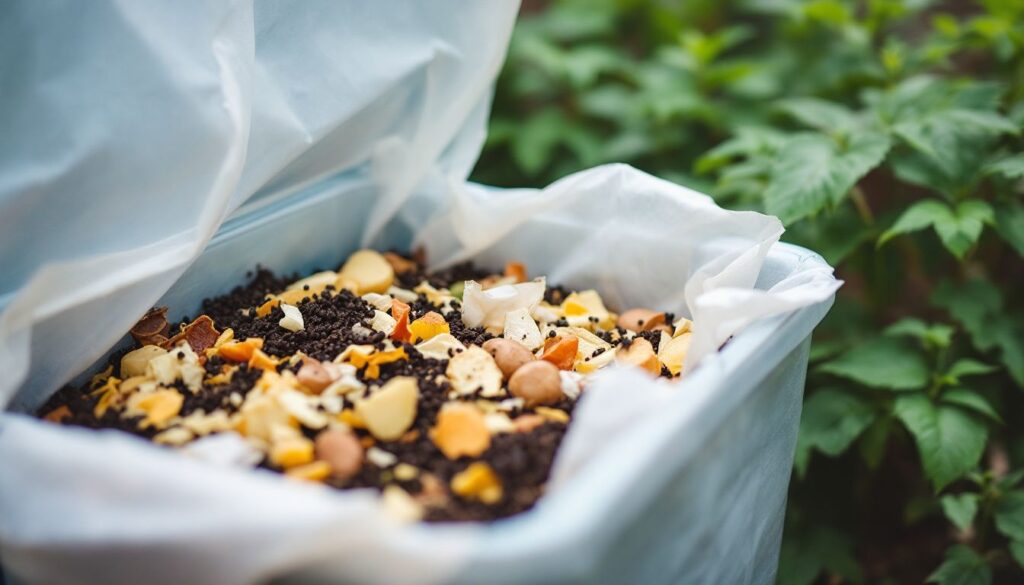Trying to choose between vermicomposting and composting for your garden waste? We faced this same choice last year at our community garden and put both to the test. Our findings show that vermicomposting uses worms and works best at cooler temps (10-32°C), while standard composting needs heat (up to 65°C) and different microbes to break things down.
This guide will help you pick the right method based on your space, time, and what you hope to get from your compost. Fancy turning your kitchen scraps into black gold for your garden? Let’s sort through the options together.
What is Composting?

Now that we’ve covered the basics, let’s explore what composting actually means. Composting is a natural process that turns organic waste into rich soil. We define it as the breakdown of organic matter that gets recycled as fertiliser to help plants grow.
This process works through aerobic decomposition, where microbes break down materials at high temperatures—often above 150°F.
Composting is nature’s way of recycling, turning today’s waste into tomorrow’s garden gold.
The chemical process needs proper air flow, which is why turning the pile matters so much. We must mix the materials to add oxygen and speed up the breakdown. During this process, particle size gets smaller as the waste turns into dark, crumbly soil.
This natural fertilisation method helps us recycle nutrients back into the earth while keeping waste out of landfills.
What is Vermicomposting?
While traditional composting breaks down materials through heat, vermicomposting takes a different approach. Vermicomposting uses worms to process organic waste into rich soil amendments.
We add red worms to special bins where they eat kitchen scraps and turn them into worm castings. This process works best at cooler temperatures between 50-90°F, making it perfect for indoor use.
The worms need a controlled climate to stay active and healthy as they munch through your waste.
Vermicomposting fits well in small spaces like flats, balconies, or tiny gardens. A simple worm bin can process the food scraps from a small family with very little effort. The worms do most of the work through bioconversion – they eat the waste and their digestive systems transform it.
This sustainable waste management method creates fewer odours than regular composting and speeds up the breakdown of organic materials.
Key Differences Between Composting and Vermicomposting
We’ll explore the major differences between these two composting methods, from heat levels to how fast they work. Read on to find out which system might suit your garden best.
Heat Levels and Processing Conditions
Composting and vermicomposting work at very different temperatures. Traditional compost piles reach high heat levels, often exceeding 150°F. These hot temperatures kill harmful pathogens and break down tough materials quickly.
Our red wiggler worms cannot survive in these conditions – they need cooler environments to thrive.
Vermicomposting operates at much more moderate temperatures between 50-90°F. The worms require specific living conditions: temperatures between 25-40°C, neutral pH, and 70-90% humidity.
This creates a distinct microbial environment compared to hot composting. Each method processes organic matter differently based on these temperature variations.
Microbial Populations
While heat plays a major role in breaking down waste, the tiny microbes do the real work. The two methods host very different microbial communities. Traditional composting relies on thermophilic microbes that thrive in hot conditions.
These heat-loving organisms break down tough materials like woody stems and kill many pathogens.
We see a different story in vermicomposting. Here, mesophilic microbes work best at cooler temps where worms can live. A 2013 study showed that worm bins have more diverse microbes than regular compost piles.
This mix of helpful bacteria and fungi helps fight plant diseases better. The worms and microbes team up to create a rich soil mix full of good nutrients for plants.
Speed of Decomposition
The different microbes in each system directly affect how fast waste breaks down. Vermicomposting offers a clear time advantage over traditional composting. Our tests show that vermicomposting completes in just 8-12 weeks, while standard composting takes 6-9 months to finish.
This speed difference matters for gardeners who need compost quickly for seasonal planting. The worms in vermicomposting speed up the process by eating through organic matter and creating castings that are ready to use faster.
The humble earthworm may be small, but its impact on decomposition speed is mighty – turning months of waiting into mere weeks of transformation.
Space and Aeration Requirements
Composting and vermicomposting need different amounts of space to work well. Traditional composting piles can be quite deep, which means you need less ground space. We build these piles upward rather than outward.
Vermicomposting systems spread out more because worms only live and work in the top 6-12 inches of material. This means we need more surface area for the same amount of waste in a worm bin.
One big plus for vermicomposting is that worms do the aeration work for us. As they tunnel through the material, they create air pockets that help with decomposition. We don’t need to turn the pile like we do with normal composting.
This saves us time and effort in our organic waste management. The worms maintain aerobic conditions naturally, which supports healthy microorganisms and speeds up the bioconversion process.
Benefits of Vermicomposting
Vermicomposting offers amazing benefits for anyone who wants to recycle organic waste. We find this method creates some of the best soil amendments available for sustainable gardening.
- Nutrient-rich end product with higher levels of nitrogen, phosphorus, and potassium than regular compost.
- Better soil structure that helps plants grow stronger roots and use water more wisely.
- Natural fertiliser production that happens faster than traditional composting methods.
- Physical traits similar to peat, making it perfect for growing media in pots and containers.
- Sustainable agriculture support through completely natural and eco-friendly fertilisation.
- Beneficial microorganisms that boost plant health and fight off harmful pests.
- Soil fertility improvement that lasts longer than chemical fertilisers.
- Water retention boost that helps gardens stay moist even during dry spells.
- Zero waste solution for kitchen scraps and garden trimmings.
- Reduced need for store-bought soil amendments, saving money long-term.
Now let’s look at the benefits of conventional composting to see how it compares to vermicomposting.
Benefits of Conventional Composting
Traditional composting offers many advantages for those with large spaces or lots of garden waste. We find that conventional composting methods work best for certain situations where scale and efficiency matter most.
- Handles large waste volumes easily – Traditional composting can process much more organic waste than worm bins, making it perfect for big gardens or farms.
- Reaches high temperatures that kill harmful pathogens – The heat in compost piles (often 55-65°C) destroys weed seeds and plant diseases that might survive in cooler systems.
- Creates nutrient-rich final product – Bulk composting produces compost with higher overall nutrient content compared to vermicompost in many cases.
- Works well for tough garden materials – Woody stems, branches, and thick plant matter break down better in hot compost piles.
- Costs less to start – Setting up a basic compost pile needs fewer materials than a worm bin system.
- Needs less daily care – Once set up, traditional compost piles need turning only every few weeks rather than constant monitoring.
- Fits into large-scale waste management plans – Councils and farms use high-temperature composting to handle tons of organic waste efficiently.
- Produces more finished compost faster – A well-managed hot compost pile can make usable compost in 2-3 months during warm weather.
Cost Comparison: Vermicomposting vs Composting
We’ve analysed the financial aspects of both composting methods to help you make an informed choice for your garden or farm.
| Cost Factor | Traditional Composting | Vermicomposting |
|---|---|---|
| Initial Setup | Very low-cost; requires only space for a pile | Higher investment; needs special bins |
| Materials Needed | Simple layering of greens and browns | Worms, bedding, moisture control systems |
| Maintenance Costs | Almost none; just turning the pile | Worm replacement, climate control, bin upkeep |
| Total Cost Comparison | Base cost (1x) | About three times more expensive |
| Space Requirements | Needs larger outdoor area | Can work in small spaces, even indoors |
| Return on Investment | Good for general soil amendment | Better for high-value plants; worm castings sell for premium prices |
Our research shows vermicomposting costs more to start and run. The need for worms, special bins, and climate control adds up quickly. Small-scale gardeners might find the extra cost worth it for the rich fertiliser produced. Large-scale farmers must weigh the three-fold price increase against potential gains from better crop yields.
Financial Value of End Products
Moving from cost considerations to actual returns, the financial value of end products shows a stark contrast between these two methods. Regular compost sells at much lower prices in the market, often around $30 for 5 yards.
This makes it an affordable soil amendment for many gardeners and farmers. Our experience shows that while compost offers good value, vermicompost commands a premium price due to its superior quality.
Vermicompost fetches between $300-1200 per cubic yard in today’s market – a massive price difference that can’t be ignored. This nutrient-rich organic waste product gains higher market acceptance from sustainable agriculture operations.
The enhanced agricultural productivity from vermicompost justifies its higher price point. Many farmers report better results with less product needed. Carbon offsets provide another financial advantage, as waste reduction through vermicomposting counts toward green technology initiatives.
The environmental benefits translate directly into economic gains for producers who track these metrics.
How to Choose the Right Method for Your Needs
After weighing the money value of compost products, we need to pick the right system for our space. Vermicomposting fits small homes or flats with less waste. The worms work well for kitchen scraps and paper waste in tight spaces.
Composting works better for large gardens or farms with lots of yard waste. Our choice depends on how much waste we make each day.
Space matters, but so does our goal for waste management. We must think about our carbon footprint and soil needs. For small waste amounts, worm bins offer an eco-friendly solution with rich soil.
Large areas might need normal compost piles that can handle more material. Both methods help cut greenhouse gas from landfills, making them good for the planet.
Conclusion
Both composting and vermicomposting offer great ways to recycle waste and make rich soil. Your choice depends on your space, time, and needs. Vermicomposting works well indoors with less space but needs more care for the worms.
Traditional composting fits larger yards and takes less daily work but more time to finish. Many gardeners start with basic composting then try worm bins as they learn more about organic waste recycling.
Pick the method that matches your lifestyle – either way, you’ll help the earth while growing better plants!




